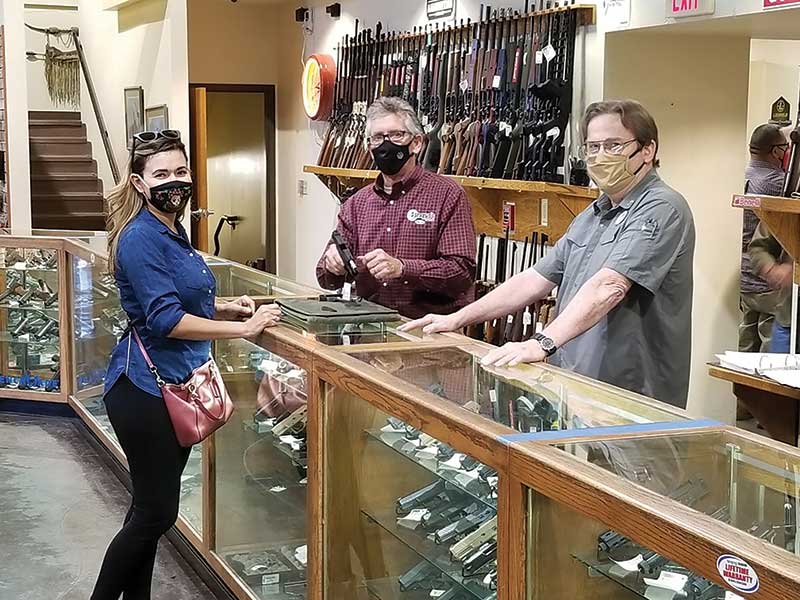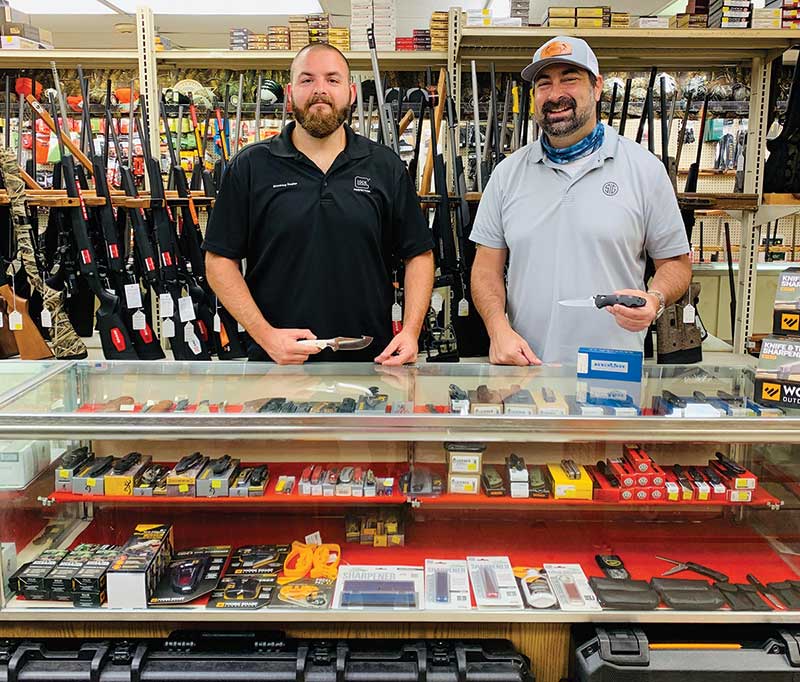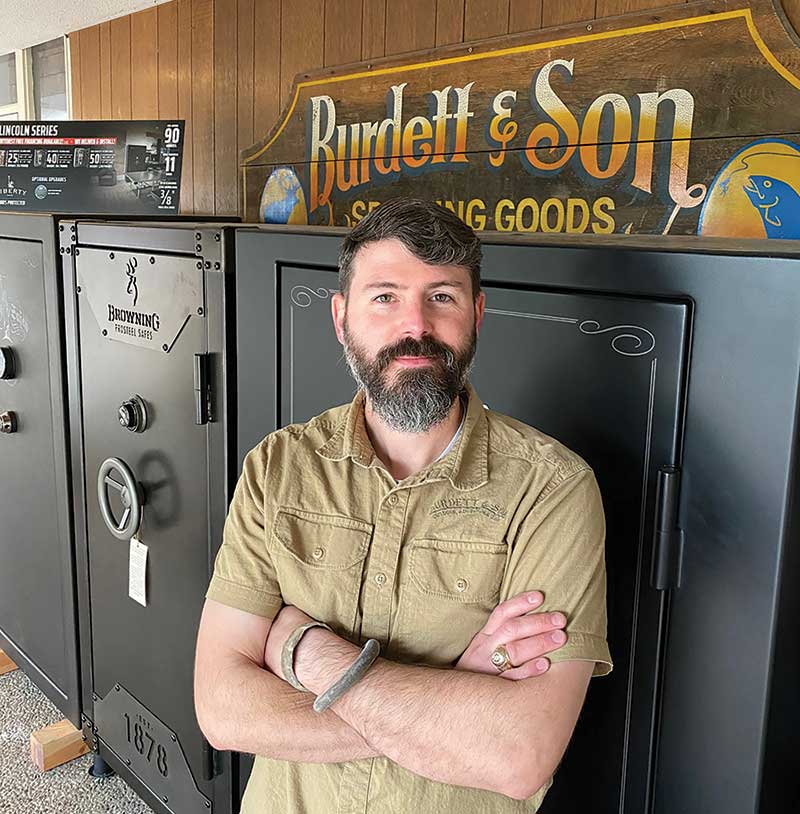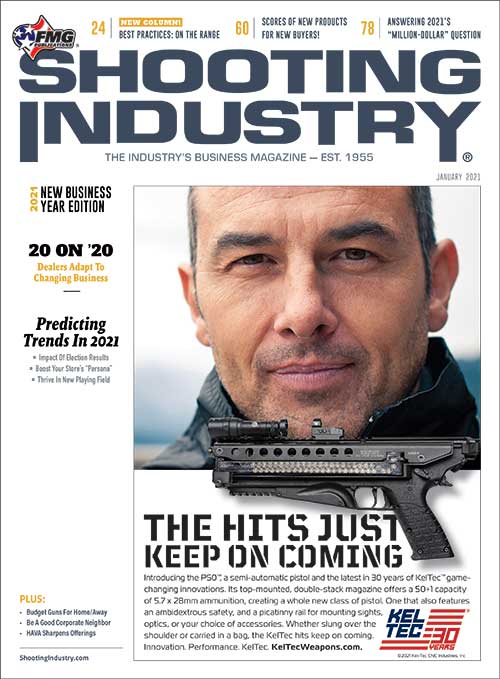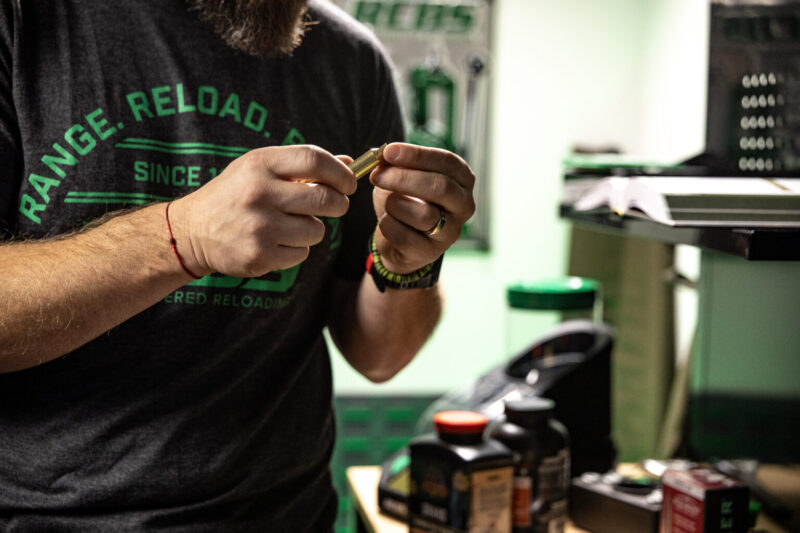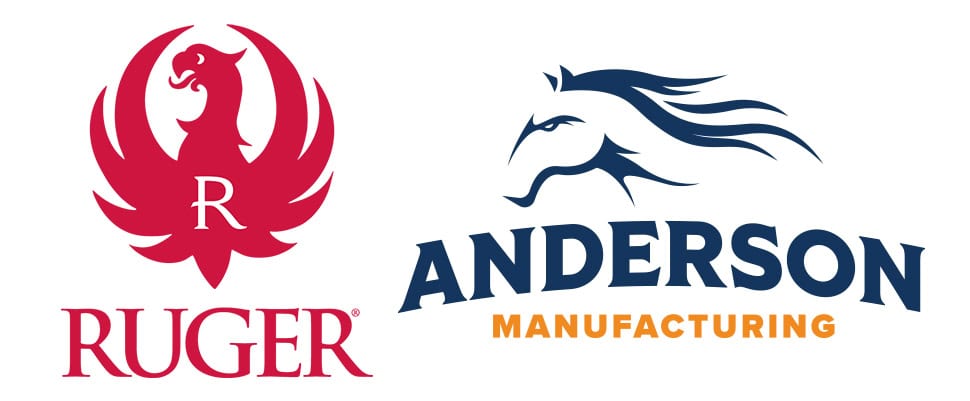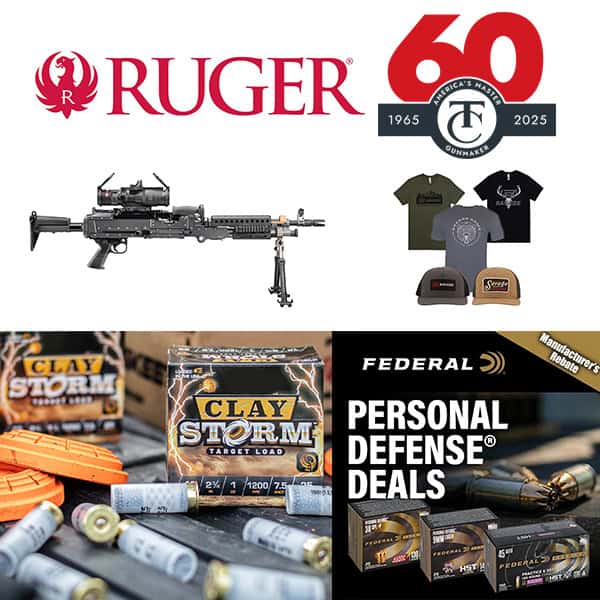Todd Piccinini, one of the owners of Mark, Fore & Strike in Reno, Nev., said at first the COVID-19 pandemic introduced a lot of uncertainty into how the family-owned store was going to conduct business.
“We were concerned about the safety of our family, the safety of our employees and the safety of our customers,” he said. “We had to balance it against what I would guess was about a 1,000% increase in business. In our state, the government did name sporting goods stores as a non-essential business, but we were fortunate enough to have a Nevada revised statute written that they cannot hinder the legal transfer of a firearm in our state. So the decision we had to make was do we shut our doors because we’re a sporting goods store, or do we ride on the shirttails of being a firearms business?”
Ultimately, the family decided to keep their doors open.
“We’re fortunate we’ve been healthy, and our business practices showed us what things were essential. We’ve done those things all these years on how to manage customer expectations; to be courteous, to take care of their needs and at the same time try to keep merchandise flowing and keep supplying the goods.”
20 on 20
A Score Of Dealers Discusses Silver Linings,
Tests Of Unprecedented Year
To say 2020 was a very strange year is to understate the obvious. Between COVID-19, unrest in many cities and towns and an election season that left many pundits just shaking their heads, 2020 has changed our lives and the way we do business. Shooting Industry spoke with 20 retailers nationwide to get their thoughts about how the year changed business in their stores.
Across-The-Board Increases
John Michaelson, general manager at Al’s Sporting Goods in Logan, Utah, said their business increased by a large margin in 2020.
“It’s across the board, and not just in guns,” he confirmed. “Our feeling is everyone who normally would have been spending money on travel — which they couldn’t do — were buying bicycles and camping gear and fishing poles. Things they could do outside. Kayaks and little boats. Athletic equipment. Trampolines. Anything to get the kids outside and doing something. Even the departments that didn’t do so well, such as hunting clothing, also went up. We heard people say they were spending their vacation money on those things.”
At Spillway Sportsman in Port Allen, La., Spencer Graham said the store saw a definite increase in the volume of their sales.
“We had a three- to four-fold increase in business in certain sectors,” he noted. “Those sectors were firearms and ammo. Early on it was AR-type firearms and tactical home-defense-type shotguns, and then handguns shortly after.
Everybody stocked up on whatever ammunition they could get; handgun ammo, 5.56 in bulk all went, as much as we could sell. The only way you’re getting product now is if you ordered it six months ago.”
Being “Essential”
At Beimert Outdoors in Brainerd, Minn., Owner Brent Beimert is thankful his store’s small selection of firearms enabled him to keep the doors open as an essential business.
“We weren’t sure we were going to be able to stay open because we’re mostly archery and archery isn’t essential,” he said. “However, the fact we have firearms made us essential, so we were one of the only bow shops open for a little while. Since people had more time, more people were buying and shooting bows than had been in the past. Spring and fall high school sports were nonexistent, so it meant both parents and kids had more time on their hands to shoot their bows and go hunting.”
Not surprisingly, Beimert’s biggest problem late in the year was getting product.
“A lot of archery companies, depending on where they are, were shut down for a couple months,” he said. “It put them behind the eight ball, and now things are a little tough to get.”
Jerry Horsley, owner of Red’s Trading Post in Twin Falls, Idaho, expressed similar experiences on being deemed “essential.”
“When COVID started, we weren’t sure we’d be able to stay open,” she acknowledged. “But we’re an essential business, so we were able to stay open. Then the panic started with everyone coming in and buying firearms like crazy. We had a lot of first-time buyers; people who never thought they would buy a gun, and people were taking classes for concealed weapons permits. This is worse than the Obama years because everyone was buying AR-15 rifles then; this is more handguns. They’re going out as fast as we get them. We were almost empty at one point because we couldn’t get any more.”
" A higher percentage of people who come into the store are going to be buyers. They’re not just kicking tires; they’re not just shopping. They’re here to buy.”
Richard Sprague, President Sprague’s Sports Yuma, Ariz.
Welcoming Anti-Gunners
Jeff Wait, owner of Okeechobee Shooting Sports in Okeechobee, Fla., shared the events of 2020 increased the number of new gun owners coming into his store and range.
“People who were anti-gun in February and actually wanted the government to forcibly remove guns from gun owners’ homes are now becoming gun owners themselves,” he stated. “The demographics have been changing rapidly. All training classes are always full. Unfortunately, it’s difficult to get the inventory to sell to everyone wanting to purchase, so I can’t make everyone happy, which affects my business in a negative way. It’s hard to make money with nothing on the shelves.”
At Mark’s Outdoor Sports in Vestavia, Ala., John Fuller relayed the changing demographics of his customer base.
“We had a lot of people coming in who had never bought a gun before,” Fuller shared. “We’ve always had a few people buying for the first time, but we had a lot more in 2020.”
Getting inventory also has been a problem.
“We haven’t been able to get much of anything we need,” Fuller said. “We’re having trouble getting 9mm ammo, 5.56, 7.62 and a lot of other pistol ammunition, including .380. We’re also having a hard time getting the more common pistols people want, such as GLOCKs and Smith & Wesson .38 Specials, home-defense shotguns and some tactical weapons. I also can’t get safes as fast as I want them; there’s a huge demand.”
Not every store reported significant changes in buyer demographics. Ray Chan, sales manager at Volusia Top Gun in Daytona Beach, Fla., said while sales were up, it was driven by regulars.
“Our demographics really haven’t changed a lot,” he shared. “We’re just seeing a lot more people and sales than before. We’re having a lot of trouble getting everything: guns, parts, accessories, ammo — everything.”
Inventory Management Headaches
In Eugene, Ore., Erin Stanton is the retail manager of Mazama Sporting Goods. The store has been doing two to three times the amount of business it usually does. Stanton shared managing inventory has been nearly impossible.
“I normally have a system in place to stock all of my back stock, but I don’t have a system in place to stock all of my pending orders,” he said. “It’s overwhelming, to say the least. For the first two quarters I was working seven days a week and now I’m down to six, so it’s better. The State of Oregon cannot keep up with the demand. With all the new gun owners coming in to buy guns, there’s not a single demographic not represented by my customers.”
Once burned by having too much inventory in the store, Paducah Shooter’s Supply (Paducah, Ky.) Manager Chance Clanahan said they went to at-once inventory.
“We got stuck with too much inventory, the distributors got stuck with too much inventory, the manufacturers had too much inventory,” he recalled. “Now, I’ve got to look at keeping more stuff in the pipeline. This is unprecedented. We’ve never seen anything like this. Normally we’re slow in the summer, but we’ve been hooked up since the milk and toilet paper ran out; that’s when things kicked off for us.”
Everything has been selling well at the store, according to Clanahan.
“I was concerned, with the way people are buying handguns and black guns, hunting stuff was going to suffer,” he stated. “But even our archery equipment is neck and neck with last year’s. And looking at what we’re selling hunting wise, we sold over a dozen muzzleloaders today.”
For the first couple weeks of the pandemic, the store did curbside delivery only.
“Customers would pull up and tell us what they wanted, and we would run in and get it,” Clanahan said. “But there’s a statute on the books to protect gun shops, and they can’t legally interfere with the lawful sale of guns and ammo. So, we didn’t have to do anything differently we had been doing. After just a few weeks it was business as usual except we’re 100% covered up with customers.”
In Sheridan, Wyo., Rocky Mountain Discount Sports Manager Ron Lee oversaw an increase in sales and supply issues.
“Sales were great, but merchandise was hard to get,” he declared. “So, our biggest challenge right now is procuring enough goods. Ammo and guns — and holsters — are very hard to get, even from our distributors.”
At Smoky Valley Shooting Sports in Lindsborg, Kan., Bridget Wampler shared the store had both an increase in overall sales, and an increase in the number of first-time gun buyers — and increased inventory challenges.
“We have had difficulty finding and getting guns,” she stated. “We’re having trouble getting ammunition and reloading supplies. We’re also an archery shop and getting bows has been delayed; we have longer wait times. We’re selling a lot more of that kind of thing, too. People couldn’t get out and do anything, but they could go out and shoot their bows.”
Helpful Hurricanes?
Due to its location in a storm-prone area, Puglia’s Sporting Goods (Metarie, La.) Owner Anthony Puglia had prepared several large orders ahead of the demand crush. By mid-October, Louisiana already had been impacted by Tropical Storm Cristobal in June, Hurricane Laura and Hurricane Marco in August and Hurricane Sally in September.
“Of course, sales increased because of COVID, but our buying and selling of firearms jumped because of other things as well,” he shared. “We always kind of anticipate sales of guns and ammo during hurricane season. When hurricanes are forecasted to make landfall in our territory, we’ve known for years we need to bump up our inventory of guns and ammo, and of course flashlights and batteries and things like that. On top of this, we had COVID — which is more of a logistics problem as far as shipping guns and ammo is concerned. Factories were only working 50% of their staff and some of them were closed, and it created a logistics nightmare when it came to getting product. Then you factor in it’s an election year, so we also anticipated our buying power had to increase because of the election. And on top of that we had the protests and rioting.”
Puglia is a member of Nation’s Best Sports, and he quadrupled his orders from NBS.
“Basically, whatever we had on our first order, we made four more orders like it to ship throughout the year,” he asserted. “So, we’re getting guns and ammo in because of the factors we anticipated. Instead of having to pick up the phone and place an order I’m not going to get right away, I’ve been able to be in line with all the gun manufacturers so we have a steady flow of inventory coming in.”
Like most other retailers, Puglia saw a record number of gun sales in June and July. Customers purchased some items faster than Puglia could get them in, but he didn’t stay out of them for long.
“There was a short supply on guns and ammo, especially on the more popular items,” he noted. “There’s a trend where people want more concealable handguns, and there’s a trend we saw with women wanting snub-nosed .38 revolvers. Another larger trend was first-time gun buyers. So, the snub-nosed .38s and compact and sub-compact semi-auto pistols were all in high demand, and along with that so were other accessories such as holsters, magazines and sights. It all fell in line, even gun-cleaning supplies. It was frantic at times, but I think we were more well off than a lot of other people because we were already aware of the time of year and we had to bump up our orders anyway.”
Handling Uncertainty
At Fin & Feather in Iowa City, Iowa, manager Brian Mildenstein said his business has been unpredictable.
“I wouldn’t say it’s specific to the shooting sports part of the business, but it’s the most unpredictable part right now,” he shared. “There’s a significant amount of supply chain interruption; things we normally expect to reorder and turn around in a short amount of time, or things we would order before a season, may or may not be materializing or may be taking quite a bit longer than we would expect them to take.”
" With all the new gun owners coming in to buy guns, there’s not a single demographic not represented by my customers.”
Erin Stanton, Retail Manager Mazama Sporting Goods Eugene, Ore.
Sales are brisk and a lot of customers are stocking up on items they think may be hard to get, which in turn leads to more shortages, Mildenstein added. Many of his customers are hunters, and he’s concerned ammo shortages during hunting season may impact their ability to hunt.
“If supply doesn’t arrive or isn’t readily available through the season, it may preempt some people from being able to go and enjoy what they like to do,” he noted. “I would call it a little concerning, just because it’s so timely.”
Joseph Duckett, front-end manager at Spotted Dog Shooting Sports in Columbia, La., recounted how small-town businesses are being adversely affected by a rush of buyers.
“Stores in big towns are going to get the first business from people who are in those towns,” he said. “But what happened this year drove a lot of people to us because they had heard of us, but they’d never been here to visit us. It threw off our ordering, so we’re having to order stuff to fill in at a time when there’s less stuff available.
This has driven us closer to our reps and to our companies to try to get more product.”
Two Waves Of Buying
As you likely experienced, Marna Miller Tracy, owner of Tampa Tactical in Riverview, Fla., recapped the two significant waves of buying impacted her store.
“At the beginning of COVID, customers came in and bought everything,” she relayed. “They didn’t care how long they waited in line, what it cost or if it wasn’t important. They just felt the need to be able to protect their families.”
Then a “whole new storm” erupted after the nationwide protests in early June.
“People felt their governor and mayors weren’t allowing law enforcement to take care of them as protests and looting and rioting got more and more progressive, so they thought ‘The police aren’t going to get there so I have to take care of my own family.’ So again, we saw people buying anything and everything,” she said.
These waves have left inventory channels depleted.
“Demand is still high, but now retailers, distributors and manufacturers are out of everything. It’s going to take a year to a year and a half for us to recover enough to be able to restock the store,” Tracy added. “Manufacturers are producing what they can, but not all of them are even open yet. Or if they are, they may not be producing at full capacity because some states may not allow them to have their factories open yet or there’s limited raw materials. For example, some of the ammunition manufacturers are having a difficult time getting primers.”
Smarter Operations
Richard Sprague, owner of Sprague’s Sports in Yuma, Ariz., saw an unprecedented demand for shooting sports products in all categories.
“It was for a longer duration than we’ve ever experienced in our 64 years in the gun business,” he shared. “It’s also made quite a few changes in the way we do business. First, we adopted all COVID guidelines. We’ve shortened our hours, and because our staff was taxed to the max, we’ve added staff. We’ve been supported well by our vendors and our partners in business we buy direct from. We’ve never had a controlled-access gun counter and now we do; people have to stand in line, they get called to the gun counter and each person has their own space.”
Sprague pointed out there’s actually been an advantage to doing business this way.
“In the past, we’d have people standing two and three deep at the counter, and we really weren’t sure who was getting helped and who wasn’t,” he admitted. “Invariably someone would get frustrated because they weren’t getting helped. Now we know everybody is in line and things are controlled and everyone gets assigned a salesperson. A higher percentage of people who come into the store are going to be buyers. They’re not just kicking tires; they’re not just shopping. They’re here to buy. That percentage has doubled or more from normal times.”
The demographic of those buyers has changed as well, according to Sprague.
“We’re drawing people from a wider radius, and we’ve got more people we’ve never seen before in the store than ever before,” he said.
Sarah Natalie, general manager of Maxon Shooter’s Supply & Indoor Range in Des Plaines, Ill., shared a new approach to timing visits and scheduling appointments.
“We had to change the way we serve our customers to be able to serve as many people as we could,” she informed.
“Obviously, retail establishments are limited by the number of staff members they have and the number of cash registers they have. We figured out how long particular transactions take, calculated about how many people we could serve for each different kind of transaction and then we went by appointment only.”
It was roundly welcomed by customers, Natalie said.
“So, we only allowed the number of appointments per day we knew we could handle to prevent things like people standing in line,” she shared. “It prevented us from having too many people in the shop at one time, and allowed us to meter the number of people in the showroom and on the range. We’ve had some very positive feedback from our customers they would like us to continue the appointment procedure post-COVID.”
Growing Diversity
Back in Riverview, Fla., Tracy shared how the demographics of her customers changed quite a bit in 2020.
“We are seeing a massive number of new gun buyers,” she recounted. “These are people who would not normally buy guns. We’re seeing more from the left side of the house than the right side of the house buying guns than you normally would. I’m also seeing more couples between the ages of 40 and 60 buying guns who would never have a gun in their house before. I’ve seen a noticeable increase in people of color who are buying guns.”
In College Station, Texas, Barry Burdett, manager of Burdett & Son Outdoor Adventure Shop, evaluated the short- and long-term effects of this crisis.
“It’s hard to say what the long-term effects are going to be, but the short-term effects look fairly good on paper,” he noted. “It’s been kind of hard on our employees because the customers have had a little different attitude than usual. Under orders from the governor we didn’t close down, but we had to limit our capacity and the times we were open. The time was more our decision because we had things we felt we were responsible to do, like sanitation and cleaning.”
In Twin Falls, Idaho, Horsley also made some alterations in how she was running the store.
" It’s difficult to get the inventory to sell to everyone wanting to purchase, so I can’t make everyone happy, which affects my business in a negative way. It’s hard to make money with nothing on the shelves.”
Jeff Wait, Owner Okeechobee Shooting Sports Okeechobee, Fla.
“At first we shortened our hours just a little bit,” she said. “We took off an hour at the end of the day because we were beat; there were just so many people coming in and so many to wait on. But it got to where we needed to be here, so we went back to our regular hours and we’re trying to do the best we can. Ammo is so short right now (in mid-October) and with it being hunting season people are coming in looking for ammo to go deer hunting and we can’t get anything.”
Classes On The Upswing
In St. Peters, Mo., Michael Knipping is the retail manager at Ultimate Defense. The events of 2020 have increased sales in the store, and increased enrollment in classes.
“It’s increased everything we do here,” he said. “We’re a retail store, a range and a training center. Sales of everything has increased, including guns, apparel, gun-cleaning products, and everything else that goes along with guns.”
Another change is in the demographics of customers; many people are coming in who have never purchased a gun before.
“They’re coming in and saying the same thing,” Knipping added. “They’re saying ‘The world has gotten to a place where I think I need a firearm to protect myself.’” (Those customers also are taking classes in large numbers, he confirmed.)
With Maxon being located in the outskirts of Chicago, the store was close to some civil unrest during the summer.
“It drove a lot of customers to our training catalog,” Natalie shared. “We’re doing five times the amount of training we were doing pre-COVID and it’s only because I’m limited by the number of instructors I have and the hours available. We could probably fill even more if I had space available.”
A Silver Lining
The impacts of 2020 on the shooting, hunting and outdoor industry will be felt for some time. While there have certainly been monumental challenges as a result of sustained demand, interest in firearms and firearms ownership is reaching entirely new groups of people — a definite win.
Now it’s up to us, as an industry, to welcome these folks back into stores and ranges in 2021.
How are you planning on generating repeat business? Share with the SI team: comments@shootingindustry.com.


